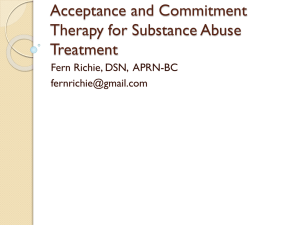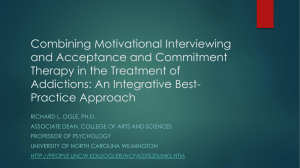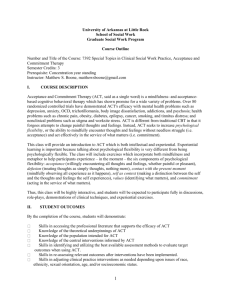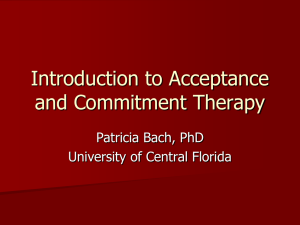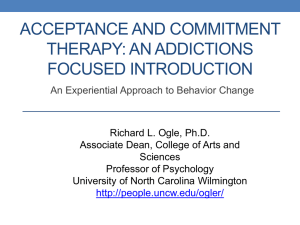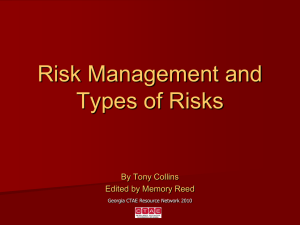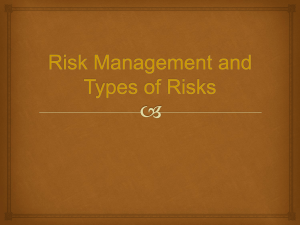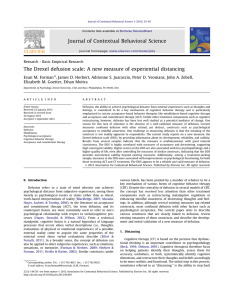Acceptance and Commitment Therapy (ACT)
advertisement
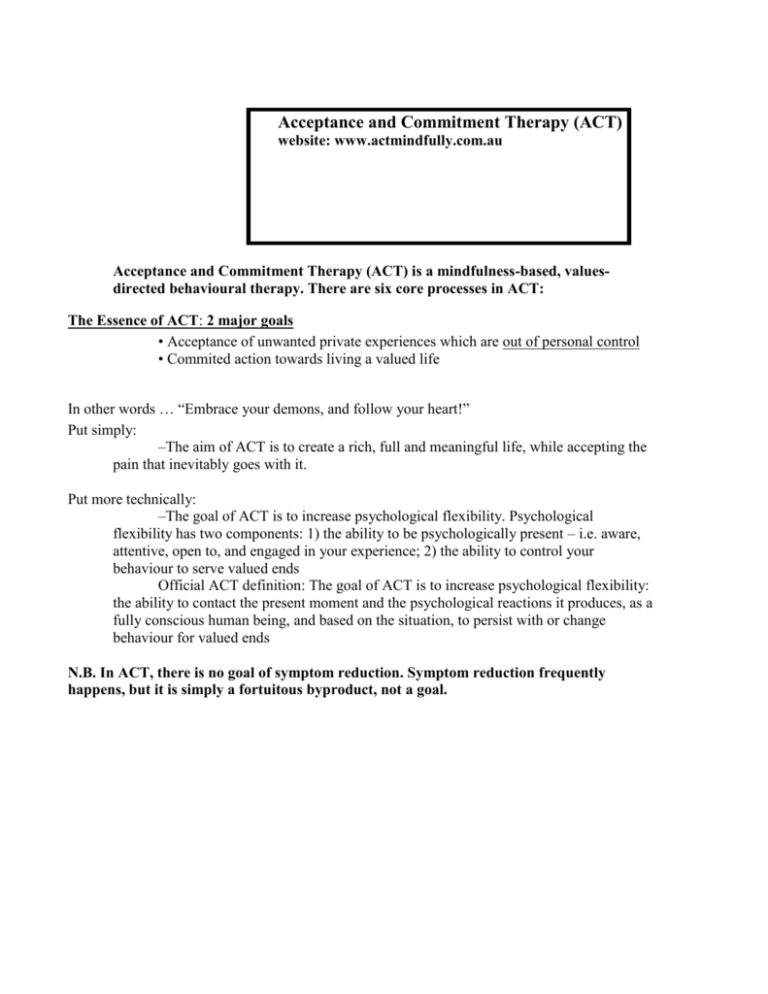
Acceptance and Commitment Therapy (ACT) website: www.actmindfully.com.au Acceptance and Commitment Therapy (ACT) is a mindfulness-based, valuesdirected behavioural therapy. There are six core processes in ACT: The Essence of ACT: 2 major goals • Acceptance of unwanted private experiences which are out of personal control • Commited action towards living a valued life In other words … “Embrace your demons, and follow your heart!” Put simply: –The aim of ACT is to create a rich, full and meaningful life, while accepting the pain that inevitably goes with it. Put more technically: –The goal of ACT is to increase psychological flexibility. Psychological flexibility has two components: 1) the ability to be psychologically present – i.e. aware, attentive, open to, and engaged in your experience; 2) the ability to control your behaviour to serve valued ends Official ACT definition: The goal of ACT is to increase psychological flexibility: the ability to contact the present moment and the psychological reactions it produces, as a fully conscious human being, and based on the situation, to persist with or change behaviour for valued ends N.B. In ACT, there is no goal of symptom reduction. Symptom reduction frequently happens, but it is simply a fortuitous byproduct, not a goal. There are six core processes in ACT: 1. Contact with the Present Moment Conscious awareness of your experience in the present moment enables you to perceive accurately what is happening Gives you important information about whether to change or persist in behaviour Enables you to ‘catch’ cognitive fusion ‘in flight’ Allows you to engage fully in what you are doing 2. Acceptance Actively contacting psychological experiences directly, fully, and without needless defense Definition: defused, open, undefended contact with the present moment, as a fully conscious human being. Colloquial: ‘Opening yourself fully to experience, as it is, not as your mind says it is’ 3. Defusion Looking at thoughts, rather than from thoughts Noticing thoughts, rather than being caught up in thoughts Seeing thoughts as what they are, not as what they seem to be Aim of Defusion is NOT to feel better, nor to get rid of unwanted thoughts Aim of Defusion IS to reduce influence of unhelpful cognitive processes upon behaviour; to facilitate being psychologically present & engaged in experience; to facilitate awareness of language processes, in order to enhance psychological flexibility 4. Self-as-context A transcendent sense of self: a consistent perspective from which to observe and accept all changing experiences. (Often called The Observing Self) It is a process, not a thing: an awareness of awareness itself: ‘pure awareness’ 5. Values Chosen life directions ‘Your heart’s deepest desires for the sort of person you want to be and the things you want to do in your time on this planet; in other words, what you want to stand for in life’ Provide motivation & inspiration Provide guidance for your actions Give life meaning Give a sense of abundance Are different to goals 6.Committed Action Overt behavior in the service of values (may require skills training) Committed action is: values-guided, effective & mindful Mindfulness The official ACT definition of mindfulness is: “The defused, accepting, open contact with the present moment and the private events it contains, as a conscious human being, experientially distinct from the content being noticed.” My own definition, for clients: “Consciously bringing awareness to your here-and-now experience, with openness, interest and receptiveness.” In ACT, mindfulness = acceptance = willingness The Assumption of Healthy Normality By their nature humans are psychologically healthy Abnormality is a disease or syndrome driven by unusual pathological processes We need to understand these processes and change them The Ubiquity of Human Psychological Suffering High lifetime incidence of major DSM disorders High treatment demand High rates of divorce, sexual concerns, abuse, violence, bullying, prejudice, loneliness Some extremely destructive behaviours are both common and non-syndromal, e.g. suicide The Example of Suicide Unknown in nonhumans but universal in human society About 10% incidence of attempts About 20% serious struggles including a plan About 20% serious struggles without a plan About 50% not associated with DSM disorder Alternative Assumption: Destructive Normality Normal psychological processes often are destructive We need to understand these processes and work within them to promote health The source of the problem is human language and cognition In ACT, the word ‘Mind’ is a metaphor for human language In other words: Language = Cognition = Mind The mind is not a ‘thing’. It is a complex set of cognitive processes, such as analysing, comparing, evaluating, planning, remembering, visualising etc… These cognitions all rely on human language. The human language: a complex system of symbols which includes words, images, sounds, and physical gestures. Cognitions = language used privately = “mind” Language is a double-edged sword: the positive side: Make maps & models of the world Predict and plan for the future Share knowledge Learn from the past Imagine things that have never existed, and then go on to create them To develop rules that guide our behaviour effectively, and help us to thrive as a community To communicate with people who are far away Learn from people that are no longer alive. Language is a double-edged sword: the negative side: Use it to spread libel and slander and ignorance To incite hatred and prejudice and violence; To criticise and condemn ourselves; To make weapons of mass destruction; To dwell on and ‘relive’ painful events from the past; To create rules for ourselves that can often be ineffective or destructive Unlike all Other Creatures on the Planet, You Cannot Avoid Pain Situationally Remember a time when …. Imagine a future where… Compare yourself to … My life would have been so much better if … Normal Cognitive/Verbal Processes Contribute to Psychopathology –Prediction of private events (e.g., pain, anxiety) –Knowledge of death –Living in the past or the future, and no longer in the moment –Comparison to an ideal –Wishing, wanting, and desiring: attachment –Social comparison / prejudice / stigma –Self-loathing –Social inhibition (e.g., fear of negative evaluation) Language developed primarily to anticipate and solve problems: Food Water Shelter Sex But above all else … DON’T GET KILLED! Essence of problem solving:- Problem = Something we don’t want Solution = Figure out how to change it, get rid of it, or avoid it This approach works well in the external world, but when we try this with our own unwanted thoughts, feelings, memories etc… it creates problems: Experiential Avoidance: simple definition – trying to avoid, suppress, or get rid of unwanted private experiences, even when it’s harmful, costly, or ineffective to do so Experiential Avoidance technical definition: - the tendency to attempt to alter the form, frequency, or situational sensitivity of negative private experience (emotions, thoughts, memories, sensations, urges, images etc.) even when attempts to do so cause psychological and behavioural harm Higher Experiential Avoidance is associated with: –Higher anxiety –More depression –More overall pathology Why Experiential Avoidance is Basic: Humans have been taught a wide variety of strategies for avoiding negative events. These work very well in the material world An unpleasant private experience is treated the same way as an external problem; it becomes a negative event to avoid or eliminate. When Is Experiential Avoidance Detrimental? 1. The process of deliberate avoidance necessarily contradicts the desired outcome 2. The regulation of private events is largely unresponsive to verbal/cognitive control 3. Avoidance is possible, but the control strategy is costly, unhealthy, or life-distorting 4. The avoided event is important Healthy Change Often Produces Painful Experiences Change is often frightening. What needs to be done may be avoided because it is experientially difficult. This suggests a major reason experiential avoidance may lead to psychopathology: It restricts needed change. “It is not the strongest of the species that survive, nor the most intelligent, but the ones most responsive to change.” –Charles Darwin, The Origin of Species N.B. NOT all forms of experiential avoidance are unhealthy. Many are positively adaptive, and others make little difference to long-term life quality. ACT only targets experiential avoidance that persists when it is costly, useless, or life distorting. In these circumstances, experiential avoidance becomes pathological. Instead of encouraging clients to use more clever ways to fight and win this war with their own thoughts, feelings, and bodily sensations, ACT helps clients step out of this war altogether. Acceptance-based treatments attempt to alter the impact of emotions and cognitions by stopping the struggle with them rather than by attempting to change their form or frequency. In other words, in acceptance-based approaches, the client's original aim of controlling his or her private experiences (e.g., emotions, thoughts, cravings, bodily states, etc.) is itself seen as modifiable Acceptance in this context means actively contacting psychological experiences directly, fully, and without needless defense - while behaving effectively. An acceptance approach does not abandon direct change efforts: It simply targets them toward more readily changeable domains, such as overt behavior or life situations, rather than personal history or automatic thoughts and feelings (Hayes, 1994). In Summary: ACT uses acceptance and mindfulness processes, and commitment and behaviour change processes, to produce greater psychological flexibility. Six Core Problems in ACT • Cognitive fusion • Experiential avoidance • Preoccupation with past or future • Over-identification with conceptualised self (self-as-content) • Disconnection from values • Ineffective action Five Basic Strategies in ACT 1 Confronting the agenda (Creative Hopelessness) 2 Control is the problem 3 Willingness is the alternative (defusion/ acceptance/ the present moment) 4 Self-as-context 5 Values and action In Cognitive Fusion: Thoughts are Reality; it’s as if what we’re thinking is actually present, here and now! Thoughts are The Truth; we literally believe them! Thoughts are Important; we take them seriously, and give them our full attention! Thoughts are Orders; we automatically obey them! Thoughts are Wise; we assume they know best and we follow their advice! In Cognitive Defusion: Thoughts are merely sounds, words, stories, bits of language, passing through our heads. Thoughts may or may not be true. We don’t automatically believe them. Thoughts may or may not be important. We pay attention only if they’re helpful. Thoughts are not orders. We don’t have to obey them. Thoughts may or may not be wise. We don’t automatically follow their advice. Helpful questions for unhelpful thoughts Is this thought in any way useful or helpful? Is this an old story? Have I heard this one before? What would I get for buying into this story? Could this be helpful, or is my mind just babbling on? Does this thought help me take effective action? Am I going to trust my mind or my experience? Contact With The Present Moment • Any mindfulness exercise, eg breath, stretching, sounds, food • Notice your feet on the floor; your body; your breathing etc. • 5-5-5 technique: Notice 5 things you can: hear, see, feel - right now Acceptance • Acceptance = willingness = mindfulness • Basic ACT Strategies: Values & Committed Action Values • What do you really want? • What do you want your life to stand for? • What sort of person do you want to be? • What sort of relationships do you want to build? • How do you want to act/behave in the world/ towards others/ towards yourself? • What do you want to do with your life? Commitment • Not a promise. • Not a prediction. • Not an attempt to be perfect. • It means: commitment to a valued direction. • Take it for granted that you will go “off-course”, and “stuff up” again and again and again. • Commit to getting back on track again, as soon as you realise what has happened. • Clarify: values / goals / actions / barriers • DAVE cycles (defusion/acceptance/ values/engagement) - build ever larger patterns of behaviour Committed action = mindful, valued, effective action Barriers to Action My version of the FEAR acronym: Fusion with unhelpful thoughts (especially evaluation and reason-giving) Excessive goals (e.g. goals too big; time frames too small; skills lacking; resources unavailable). Avoidance of discomfort Remoteness from values My antidote to the FEAR acronym: DARE Defusion Acceptance of discomfortRealistic goalsEmbracing values feelings, or sensations. It is important that they realise this is simply to teach them a skill. In the world of everyday living, the idea is that when distressing thoughts and feelings arise, they can be accepted as just one aspect of awareness (one performer among many on the stage) - rather than completely dominating awareness (one performer standing in a spotlight). A Few Words on Acceptance Clients often don’t understand what acceptance is – so early on in therapy, I avoid the word. Instead I usually say something like: “You don’t have to like it, want it, or approve of it – simply … … allow it to be there (simply because it already is) … give it permission to be where it already is … let go of struggling with it … stop fighting with it … make peace with it … make room for it … soften up around it … let it be … breathe into it … stop wasting your energy on pushing it away The Willingness-and-Action Plan My goal is to: The values underlying my goal are: Thoughts, feelings, sensations, urges I’m willing to have (in order to achieve this goal):• Thoughts: • Feelings: • Sensations: • Urges: • It would be useful to remind myself that • I can break this goal down into smaller steps, such as • The smallest, easiest step I can begin with is • The time, day and date that I will take that first step, is 4 Approaches To Any Problematic Situation In any problematic situation, there are 4 possible approaches to consider. I find it very helpful to actually write these approaches down for clients (and myself, at times!) so they can see they have a choice about what to do: • Option One: leave the situation • Option Two: stay, and change what can be changed • Option Three: stay, and accept what can’t be changed • Option Four: stay, and rely on emotional control strategies Let’s take a look at each in turn. Option One: Leave the situation. To leave is not always an option – for example, if you happen to be in prison. However, if leaving a problematic situation is possible, then it’s worth considering: would your overall quality of life be better if you left than if you stayed? Of course, you can never know this for certain, but you can make a reasonable prediction based on what has happened up to this point. Option Two: Stay & change what can be changed. If you choose to stay in a difficult situation, the first step is to change whatever possibly can be changed to improve it. And in any situation, what you have most control over is the action that you take. So focus your energy on taking action, guided by your values, to make things as good as they possibly can be. Depending on the context, this might involve anything from practicing assertiveness or communication skills, to spending more quality time with your partner, to filing a law suit or restraining order. Option Three: stay, accept what can’t be changed, & live by your values If you’ve chosen to stay, and you’ve taken every action possible to improve the situation, and it’s still difficult, then it’s time to practise acceptance. Make room for those painful feelings. Defuse those judgmental, hostile, despairing or self-defeating thoughts. Catch yourself ruminating and worrying, and come back to the present moment. Choose to live by your values, and engage in the present moment, irrespective of the challenges you face. (In fact, option two and option three ideally will occur simultaneously. Think of Victor Frankl, living by his values in the midst of that unbearable suffering in the Nazi concentration camps.) Option Four: Stay, give up, and make it worse through ineffective action All too often, people stay in a problematic situation, but they don’t do everything possible to improve it, and nor do they practice acceptance. Rather they worry, ruminate, and analyse, or get angry, anxious, or depressed. And then they turn to emotional control strategies to try and feel better. The variety of emotional control strategies that humans use in these situations is virtually endless: drugs, alcohol, TV, food, self-harm and suicidality. Invariably, emotional control strategies just create even more suffering in the long term.
